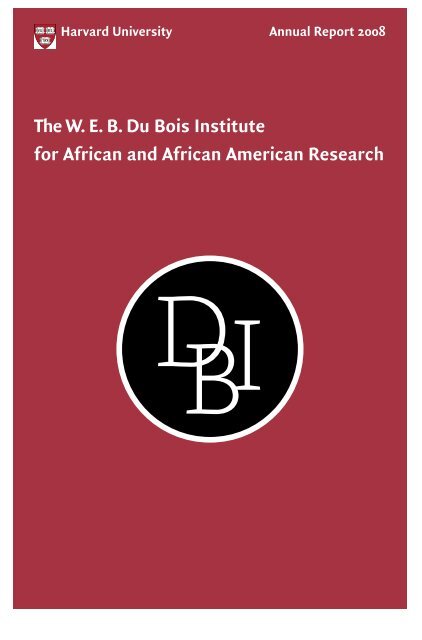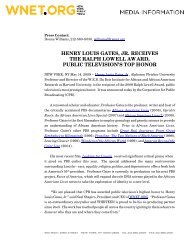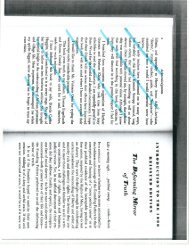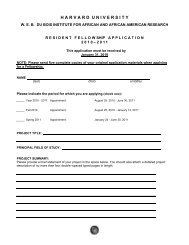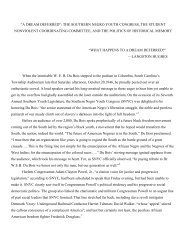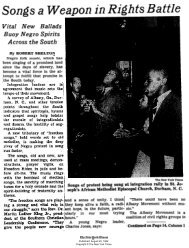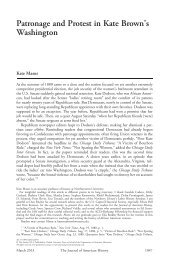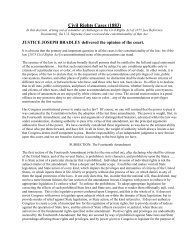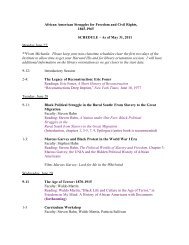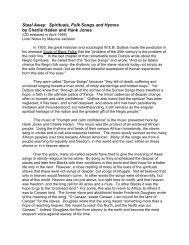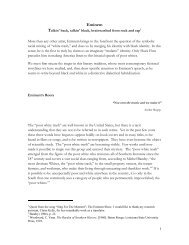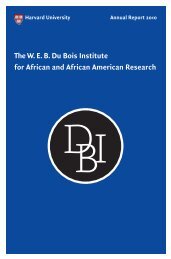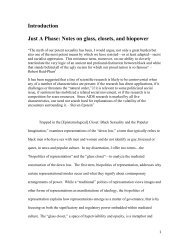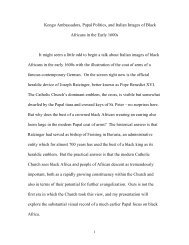AR-v.5 (1-27):Layout 1 - Hutchins Center - Harvard University
AR-v.5 (1-27):Layout 1 - Hutchins Center - Harvard University
AR-v.5 (1-27):Layout 1 - Hutchins Center - Harvard University
You also want an ePaper? Increase the reach of your titles
YUMPU automatically turns print PDFs into web optimized ePapers that Google loves.
<strong>Harvard</strong> <strong>University</strong>Annual Report 2008The W. E. B. Du Bois Institutefor African and African American ResearchDBI1
Understanding our history,as Americans and as African Americans,is essential to re-imagining the future of our society.How black people endured and thrived,how they created a most compelling culture thatis uniquely American,how they helped write the story,both figuratively and literally, of this great country,is one of the most stirring sagas of the modern era.Henry Louis Gates, Jr.Director, The W. E. B. Du Bois Institute for African and African American Research2
Annual Report 2008The W. E. B. Du Bois Institutefor African and African American Research<strong>Harvard</strong> <strong>University</strong>, 104 Mount Auburn Street, 3R, Cambridge, MA 02138617.495.8508 Phone 617.495.8511 Fax www.dubois.fas.harvard.edu
About the InstituteInstitute’s SupportersThe W. E. B. Du Bois Institute is the nation’soldest research center dedicated to the studyof the history, culture, and social institutions ofAfricans and African Americans. Named afterthe first African American to receive a Ph.D. from<strong>Harvard</strong> <strong>University</strong>, William Edward BurghardtDu Bois (1895), the Institute was established inMay 1975 to create fellowships that would“facilitate the writing of doctoral dissertations inareas related to Afro-American Studies.” Today,the Institute awards fifteen fellowships annuallyto scholars at various stages in their careersin the fields of African and African AmericanStudies, broadly defined to cover the expanse ofthe African Diaspora. The Du Bois Institute’sresearch projects and visiting fellows form thevital nucleus around which revolve a stimulatingarray of lecture series, art exhibitions, readings,conferences, and archival and publicationprojects.Realizing our dream of a permanent home in<strong>Harvard</strong> Square for the Du Bois Institutewould not have been possible without theencouragement and support of formerpresidents Derek Bok, Neil L. Rudenstine, andLawrence H. Summers; Provost Steven E.Hyman; Former Deans of the Faculty of Artsand Sciences Henry Rosovsky, Jeremy Knowles,and William C. Kirby; Dean of the Faculty ofArts and Sciences Michael D. Smith; AssociateDean for Faculty Development Laura GordonFisher; Former Divisional Dean for SocialSciences David Cutler; and Assistant Dean forAcademic Affairs Rebecca E. F. Wassarman.Henry Louis Gates, Jr.,Director, The W. E. B. Du Bois Institutefor African and African American Researchpage 1: Visitors to the Institute are greeted by a portrait of Du Boisby photographer and scholar Carl Van Vechten.2
ExecutiveCommitteeFacultyAdvisory BoardNationalAdvisory BoardEmmanuel AkyeampongHenry Louis Gates, Jr.Evelyn Brooks HigginbothamWilliam Julius WilsonHenry Louis Gates, Jr., ChairEmmanuel K. AkyeampongSuzanne Preston BlierScott BrewerJames I. Cash, Jr.Alan CounterFelton James EarlsDavid EvansPeter J. GomesLani GuinierEvelyn Brooks HigginbothamLinda HillJennifer HochschildRandall L. KennedyMartin L. Kilson, Jr.Florence C. LaddMichele LamontSara Lawrence-LightfootCharles J. Ogletree, Jr.Jacob OluponaOrlando PattersonAlvin F. PoussaintDeborah Prothrow-StithRobert J. SampsonDavid A. ThomasDavid B. WilkinsPreston N. WilliamsCharles Vert WillieWilliam Julius WilsonGlenn H. <strong>Hutchins</strong>, ChairDeborah Tanner AbellBennett AshleyPeggy Cooper CafritzGaston CapertonRichard D. CohenElthelbert CooperNorman EpsteinAlphonse Fletcher, Jr.Richard GilderLewis P. Jones, IIIWilliam LewisRobert McG. LilleyJoanna LipperMark C. MamolenDonald B. and Catherine C. MarronHenry W. McGee IIIRaymond McGuireRory MillsonClare MuñanaDonald E. and Susan NewhousePeter NortonE. Stanley O’NealJennifer Ward OppenheimerNicole ParentFrank H. and Geryl T. PearlRichard L. PleplerAndrew RamroopSteve RattnerLynda ResnickDanny RimerDaniel and Joanna S. RoseDaryl RothGeorge T. WeinDavis Weinstock3
Letter from the DirectorPhoto: Joe SinnottSince its founding in 1975, the mission of theW. E. B. Du Bois Institute for African and AfricanAmerican Research has been built upon a foundationcreated by the <strong>Harvard</strong>-trained historians W. E. B.Du Bois (Ph.D. 1895), Carter G. Woodson (Ph.D.1912), and Nathan I. Huggins (Ph.D 1962).The Du Bois Institute embodies their commitmentto excellence, and it has become the nation’s topresearch center dedicated to the study of the history,culture, and social institutions of Africans andAfrican Americans. Because of the steadfast supportof so many friends and colleagues, the Institutehas moved into a new 10,000 square foot space inthe heart of <strong>Harvard</strong> Square.The Institute consists of three floors housingAfrican and African American art and artifacts,the John Hope Franklin Collection of Africana andAfrican Americana, the <strong>Hutchins</strong> Family Library,the <strong>Hutchins</strong> Family Seminar Room, the Celia andHenry McGee, III, Black Film Poster Collection,as well as the Neil L. and Angelica ZanderRudenstine Gallery, which regularly houses specialexhibitions by leading artists such as MariaMagdalena Campos-Pons, Paul Stopforth, IsaacJulien, and Carrie Mae Weems.It has long been my desire to see a vibrant centerof scholarship and research on <strong>Harvard</strong>’s campusand our new space marks the first time all of ourresearch projects, fellows and staff can capitalize onthe unique intellectual possibilities for collaborationthat one physical space provides. The Institute’snew home is one of <strong>Harvard</strong>’s greatest achievements– it is a remarkably beautiful visual testimony tothe work to which so many scholars and supportershave dedicated their lives.The Institute’s staff, fellows, faculty andproject directors continue to expand the disciplineof African and African American research with thecompletion of such projects as the comprehensiveeight-volume African American National Biographypublished by Oxford <strong>University</strong> Press in 2008; theongoing digitization by the Andrew W. MellonFoundation of the Image of the Black in Western ArtPhoto Archive, which boasts 30,000 photographsof persons of African descent; and the airing of thesequel to the PBS series “African American Lives.”The breadth and depth of our work at theInstitute simply could not be achieved without thesupport of the <strong>Harvard</strong> administration, faculty,students, and our National Advisory Board, and forthat I am deeply grateful.As we embark on the new academic year,we will be saying farewell to Dell Hamilton, at leastin her role as Assistant Director of the Institute.Dell joined the staff in August, 2003, as our Eventsand Publications Manager, as an AdministrativeFellow. Dell quickly established herself as anenergetic and innovative member of our administrativeteam, indispensable to achieving thegrowth that we envisioned then for the Institute.Her long hours, her total devotion to the mission ofthe Institute, her kind and generous demeanor,and her intellectual range and depth made her theideal Assistant Director of the Institute, a position4
she assumed in August, 2007. Now, she has decidedto pursue graduate work in the arts. We shall missher enormously. But I am pleased to say that Dellwill continue to work for the Institute on a part-timebasis, helping to coordinate our public seminars,panel discussions, and lecture series. We knowthat Dell will be just as successful in her studies inart school as she has been with us at <strong>Harvard</strong>.Our debt to her for the Institute’s remarkable growthover the past five years will be difficult to repay.Vera Grant, our Fellows Officer, has agreedto succeed Dell as the Institute’s new AssistantDirector. She is completing her Ph.D. thesis inModern European History on Transnational Race inthe U.S. Occupation Zone in Germany, 1918–1923.Vera joined us from Stanford, where she wasthe Associate Director of the Program in African andAfrican American Studies, and in her year with us,she has already demonstrated superior leadershipskills and great generosity of spirit. We all eagerlyanticipate her assuming the duties of the AssistantDirector of the Institute.We are also welcoming, warmly, the return to<strong>Harvard</strong> from Stanford of The Hiphop Archive,conceived by Professor Marcyliena Morgan when shewas an Associate Professor in the Department ofAfrican American Studies, then relocated to Stanfordwhen Professor Morgan accepted a position there.I am so very pleased that The Hiphop Archive – theworld’s first research and archive center devotedto what is, arguably, the most important culturalphenomenon in the past three decades – will behoused in a remarkably beautiful and functionalspace on the second floor of the Institute, adjacent tothe <strong>Hutchins</strong> Family Library and the <strong>Hutchins</strong>Family Seminar Room. We plan to host the openingof the Hiphop Archive early in the fall semester.In addition to being an important academic additionto the <strong>Harvard</strong> community, the newly renovatedspace within the Institute is an architectural marvel.Welcome home, Marcy!I would like to thank Glenn <strong>Hutchins</strong> for hissuperb leadership of the Institute’s National AdvisoryBoard, and for each of its members for theirgenerosity and support.During my sabbatical in the second semester ofthe academic year, Evelyn Brooks Higginbothamgenerously agreed to serve as the Institute’s ActingDirector. She did so with aplomb and grace andelegance, and the staff and I are deeply appreciativeto her for all that she did to make the academicyear so very successful. I have asked her to write anaccount of her activities and impressions of hersemester at the Institute, and it follows on the nextpage of this Annual Report.Henry Louis Gates, Jr.Director, The W. E. B. Du Bois Institutefor African and African American ResearchAlphonse Fletcher <strong>University</strong> Professor5
Reflections of the Acting-DirectorAs the Acting-Director of the W. E. B. Du BoisInstitute during the Spring semester 2008, I came toappreciate more than ever its important multifacetedcharacter. The Du Bois Institute is a place bustlingwith activities that enrich the educational and culturalmission of <strong>Harvard</strong> <strong>University</strong>. With Henry LouisGates, Jr., on sabbatical in Palo Alto, California,I was able to witness firsthand such diverse activitiesas the W. E. B. Du Bois Fellows Program, the weeklyDu Bois Colloquium, the endowed lecture series,a Boston program for minority pre-college youth,two major art exhibits, the renovation for theinstallation of the Hiphop Archive, and numerousongoing research projects (for example, that ofsociologist William Julius Wilson and the project ofeconomist Roland Fryer). And I worked with anincredibly talented group of people – the Du BoisInstitute staff. In every capacity, they are committedto bringing exceptional programs and services to<strong>Harvard</strong>, the larger scholarly world, the blackcommunity, and broader public. I have also beenimpressed with the important partnering that occursbetween Du Bois and other groups. The rich arrayof programs offered this year was made possiblethrough the generous support of the Du BoisInstitute in cooperation with other schools anddepartments in the university as well as other outsidefunding. As I reflect upon the Institute’s manyaspects and events, I would like to share my thoughtson a few that were particularly fascinating to me.I found it very rewarding to get to know thevarious W. E. B. Du Bois fellows and their work.I learned a great deal from hearing their formalpresentations at the Wednesday colloquium. I wasalso pleased to be able to participate in the selectionof the upcoming group of W. E. B. Du Bois fellows.The academic year 2008–09 promises to havean interesting array of research projects by seniorand junior scholars, a doctoral candidate completingher dissertation, and a filmmaker.Nothing could have been more exciting for methan watching the renovation of the Hiphop Archive.This is an amazing configuration of office space,archival-research capacity, and museum-like representationof posters and even a simulated dancefloor. Indeed the Hiphop Archive under the directionof Professor Marcyliena Morgan has returned to<strong>Harvard</strong> in grand style. We are, in a word, thrilled.It was always a pleasure to introduce thespeakers of the Institute’s different named lectureseries and to listen to their three-day talk:on April 22–24, the McMillan-Stewart Lecture wasgiven by Tulane professor Jean Godefroy-Bidimaon “Nature and Politics in Africa: SomeEnvironmental Considerations.” The Nathan I.Huggins Lecture was given by the sociologist anddemographer Richard Alba of the <strong>University</strong> atAlbany, SUNY. This marked the first year that someoneoutside the discipline of History had given theHuggins Lecture. Alba’s topic, “Blurring theColor Line: Possibilities for Ethno-Racial Change inEarly 21st Century America” addressed issues ofsocial transformation in the United States,particularly ethnic and racial changes underway andtheir effect on the job market in the decadesahead. Few of us in the audience will forget Alba’sdiscussion of what he termed the “Obama factor.”Probably the greatest highlights for me werethe conferences that the Du Bois Institute helped tosponsor in partnership with other campus andoutside organizations. Since I made introductions onbehalf of the Institute, I attended these conferences,receiving in return a broad education (the conferencestruly captured the diasporic nature of theblack experience) and also a deeper appreciation ofthe crucial role of the Du Bois Institute in speakingto many different constituencies. For example,in March I went to the Ifa Oracle Conference,convened by Professor Jacob Olupona, Chair of theCommittee on African Studies at <strong>Harvard</strong>. Theconference was a global event, attracting personsfrom <strong>Harvard</strong>, the Yoruba community in6
Massachusetts, and Nigerian dignitaries, includingthe Ooni of Ife. In March the Du Bois Institutealso featured the artist Suesan Stovall. She lecturedand sang. The work of this talented young artistwas exhibited for several months at the Institute.April was by far my busiest month. The Du BoisInstitute co-sponsored “The Practice andPerformance of Cultural Creativity in the Ethiopianand American Diaspora,” which was convenedby Professor Kay Shelmay. Like the Ifa conference,the Ethiopian conference attracted many peoplefrom outside <strong>Harvard</strong>, especially those fromBoston’s Ethiopian community. Its focus was onartistic, musical, and religious practices in Ethiopiaand America. Moving next to Russia with love,the Du Bois Institute co-sponsored a conference onAlexander Pushkin, this great man and writerof African descent. The final April conference thatI attended was the Du Bois Institute’s co-sponsoredevent on the hit HBO television series, “The Wire.”The television show (now no longer produced)features youth life in inner-city Baltimore, and theconference attracted such huge audience of fans.Indeed so many people stood in line on John F.Kennedy Boulevard in front of the Kennedy Schoolthat unfortunately many had to be finally turnedaway for lack of available seating. I first heard aboutthe show through my colleague William JuliusWilson, an avid fan who praises its weekly featuresas primetime sociology lessons. The instructivenature of the show was certainly apparent at theconference, which brought together the show’sproducer David Simon and co-panelists – sociologistSudhir A. Venkatesh at Columbia <strong>University</strong>,community leader Geoffrey Canada, head of theChildren’s Zone in Harlem, and police officerNora Baston of the Boston Police Department. Eachspeaker brought a different perspective to understandingthe troubled conditions of urban streets –youth violence, drug culture, and failing educationalsystems. As provocative as the panel was, I foundequally fascinating the discussion at the dinnerco-hosted by the Du Bois Institute. It was at thisevent that <strong>Harvard</strong> professors had a chance to speakwith Simon and to discuss the educational usesand pedagogical possibilities of his program.Now that my six months at the helm of the DuBois Institute is over, I welcome back Henry LouisGates, Jr. and thank him for his many years ofleadership. Skip’s boundless energy and grand visionhave made possible the sophisticated programmingthat the Du Bois Institute offers. Because of himand certainly the financial generosity of others, theInstitute is a spacious marvel to behold – bothaesthetically and functionally designed to maximizeits intellectual and educational mission. I lookforward to the events of the upcoming year.Evelyn Brooks HigginbothamVictor S. Thomas Professor of History and ofAfrican and African American Studies7
S P E C I A L E V E N T : A PANEL DISCUSSIONHBO’s The Wire: Racial Inequality and Urban RealityDavid Simon shares his experience of “The Wire.”Professor Lani Guinier participates from the audience.Cambridge, MassachusettsApril 4, 2008JFK Institute of PoliticsCo-sponsorsHBODepartment of African and African American Studies,<strong>Harvard</strong> <strong>University</strong>The Rappaport Institute, <strong>Harvard</strong> <strong>University</strong>Program in Criminal Justice Policy and Management,<strong>Harvard</strong> <strong>University</strong>Wiener <strong>Center</strong> for Social Policy, <strong>Harvard</strong> <strong>University</strong>ModeratorWilliam Julius Wilson, Lewis F. and Linda L. Geyser<strong>University</strong> Professor, <strong>Harvard</strong> <strong>University</strong>PanelistsDavid Simon, Creator, “The Wire”Nora L. Baston, Deputy Superintendent, Boston PoliceSudhir Venkatesh, Professor, Columbia <strong>University</strong>Geoffrey Canada, President, Harlem Children’s ZoneThe audience views excerpts from HBO’s “The Wire.”Panelists give their views on creating and viewing “The Wire.”8
Panel discussion of representations of “Racial Inequality and Urban Reality” on “The Wire.”William Julius Wilson discusses “The Wire’s” impact on media landscape.9
S P E C I A L E V E N T : A P A N E L D I S C U S S I O NThe New Face of AIDS:Our Mothers, Our Sisters, Our DaughtersOld Whaling ChurchEdgartown, Martha’s VineyardAugust 24, 2007Co-sponsorHBOModeratorCharlayne Hunter-GaultPanelistsDr. Helene Gayle, President/CEO, C<strong>AR</strong>EProfessor Helen Rees, Witwatersrand <strong>University</strong>(South Africa)Dazon Diallo, Founder, SisterLoveDazon Diallo, Founder, SisterLove10
An enthusiastic crowd lines up patiently before the start of the evening. Photo: Mark Alan Lovewell Charlayne Hunter-GaultFrom left: Geeta Gupta, Helene Gayle, Dazon Diallo, Henry Louis Gates, Jr., Charlayne Hunter-Gault, and Arese Carrington11
Fellows Program2007–08 Du Bois Institute Fellowsfront row, from left: Gertrude M. James González de Allen, Barbara Rodriguez, Henry Louis Gates, Jr. (Director),Glenda R. Carpio, Dell Hamiltonmiddle row: Joanne Seo, Karla Holloway, Carla Kaplan, David Olugbenga Ógúngbilé, Sharon Harley, Paul Kaplanback row: Allyson Nadia Field, Linda Heywood, Mia L. (Amanda) Bagneris, Hudita Nura Mustafa, Mathias Bös,Charlotte Szilágyi2007–08 Du Bois Institute Fellowsfront row, from left: Samuel Raditlhalo, Sharon Harley, Evelyn Higginbotham (Acting Director, Spring 2008),Linda Heywood, Carla Kaplanmiddle row: Mia L. (Amanda) Bagneris, Kimberly McClain DaCosta, Karla Holloway, David Olugbenga Ógúngbilé,Charlotte Szilágyiback row: Allison Blakely, John Thornton, Paul Kaplan, Hudita Nura MustafaThe Fellows Program is the oldest of the Institute’sactivities and its up to twenty annual visiting scholarsreflect the interdisciplinary breadth of Africanand African American Studies. The Institute hasappointed Fellows since its founding in 1975and supports research at both the pre-doctoral andpostdoctoral levels.Du Bois Fellows are truly international,including scholars from Africa, Asia, Europe, andLatin America. The Institute’s Mandela FellowsProgram is sponsored by the Andrew W. MellonFoundation in collaboration with the <strong>University</strong> ofCape Town. With more than 300 alumni, manyformer fellows are now major figures in the field,including: Evelyn Brooks Higginbotham (<strong>Harvard</strong><strong>University</strong>), Brent Edwards (Columbia <strong>University</strong>),George Frederickson (Stanford <strong>University</strong>),Gloria Wade Gayles (Spelman College), Nell IrvinPainter (Princeton <strong>University</strong>), Arnold Rampersad(Stanford <strong>University</strong>), Claude Steele (Stanford<strong>University</strong>), and Cornel West (Princeton <strong>University</strong>).Fellows examine the Zealy/Aggasiz daguerreotypes in the Weissman <strong>Center</strong> arranged by the Peabody Museum.Barbara Rodriguez takes a close look . . .12
The Du Bois ColloquiumThe weekly Du Bois Colloquium offers a forumfor <strong>Harvard</strong> faculty and Institute Fellows to presenttheir work in progress. Previous speakers include:Wole Soyinka, Ira Berlin, Orlando Patterson,Claude Steele, Jamaica Kincaid, Hazel V. Carby, andZadie Smith. Colloquia take place every Wednesdayduring the academic year, noon–1:30 pm, inthe Thompson Room, at the Barker <strong>Center</strong> for theHumanities.2007–08 Colloquium SpeakersMia L. (Amanda) Bagneris*Doctoral Candidate in the Department of Africanand African American Studies, <strong>Harvard</strong> <strong>University</strong>“Coloring the Caribbean: Agostino Brunias andthe Painting of Race in the Eighteenth-Century BritishWest Indies”Allison Blakely*Professor of European and Comparative History,Boston <strong>University</strong>“Afro-Europe: A Neglected Dimension of theNew Immigration”Mathias Bös*Professor of Applied Sociology, Phillips <strong>University</strong>of Marburg“Race and Ethnicity – The History of Two Conceptsin American Sociology”Glenda R. Carpio*Associate Professor of African and African American Studiesand of English and American Literature and Language,<strong>Harvard</strong> <strong>University</strong>“Ambivalent Alliances: Black and Latino/a Narrativein the Americas”Kimberly McClain DaCosta*Associate Professor of African and African American Studiesand of Social Studies, <strong>Harvard</strong> <strong>University</strong>“Black Magic: African American Advertising, SymbolicBoundaries and the Making of Inequality”Gertrude M. James González de Allen*Assistant Professor of Philosophy, Spelman College“Sediments and Interceptions: Reflections on Encounter andthe Development of Transnational Identities in theU.S. Virgin Islands”Allyson Nadia Field*Doctoral Candidate, Department of Comparative Literature,<strong>Harvard</strong> <strong>University</strong>“Filming Back and Black: Strategies of African AmericanPolitical Modernism”Sharon Harley*Chair and Associate Professor of African American Studies,<strong>University</strong> of Maryland“Dignity and Damnation: Black Women NegotiatingFreedom and Patriarchy in the Post-EmancipationUnited States”Paget HenryProfessor of Sociology and Africana Studies, Brown<strong>University</strong>“Du Bois and the Classical Sociological Tradition”Linda Heywood*Professor of History and of African American Studies,Boston <strong>University</strong>“Uncovering Memory, Constructing Histories:The King of Kongo and Queen Njinga in Brazil”Karla Holloway*Professor of English and of Law, Duke <strong>University</strong>“Privacy Matters: Forensics, Pharmaceuticals and‘Who’s Your Daddy?” – Public DNA”13
Du Bois ColloquiumFrancis Abiola IreleVisiting Professor of African and African American Studiesand of Romance Languages and Literatures,<strong>Harvard</strong> <strong>University</strong>“Response to the Two Day International Symposium:F. Abiole Irele Celebration: Africa in the World,the World in Africa”Gene JarrettAssociate Professor of English, Boston <strong>University</strong>“The Conventional Blindness of the Caucasian Eye:Harlem Renaissance and the Problem of HenryOssawa Tanner”Carla Kaplan*Davis Distinguished Professor of American Literature,Northeastern <strong>University</strong>“Miss Anne in Harlem: The White Women of theBlack Renaissance”Paul Kaplan*Professor of Art History, Purchase College“Black Africans in Venetian Art and Society,1490–1590”Gretchen Long*Assistant Professor of History, Williams College“Doctoring Freedom: The Politics of African AmericanMedical Care, 1840–1910”Maxim Matusevich*Independent ScholarMcMillan-Stewart Fellow, Du Bois Institute“Practicing Beauty: Gender, Urbanism andCultural Creativity in Contemporary Dakar”David Olugbenga Ógúngbilé*Senior Lecturer in Comparative Religion and AfricanReligions, Obafemi Awolowo <strong>University</strong>“Divine Manifestation and Human Creativity:Cultural Hermeneutics of Myth, Ritual and IdentityAmong the Osogbo-Yoruba People”Samuel RaditlhaloSenior Lecturer, Department of English and Literature,<strong>University</strong> of Cape TownMandela Fellow, Du Bois Institute“Unsung Hero: The Life of Hamilton Mshado Naki”Barbara Rodriguez*Independent Scholar“‘Portrayed in Blood’: Innocents, Violence, and theLegacy of Nat Turner’s Revolt”Joanne Seo*Assistant Professor, Department of Classics andProgram in Comparative Literature, <strong>University</strong>of Michigan“The Complete Works of Juan Latino, the First BlackPoet, Translated and Edited with Literary andHistorical Notes”Charlotte Szilágyi*Doctoral Candidate in Comparative Literature,<strong>Harvard</strong> <strong>University</strong>“FRAMED! The ‘Other’ Subject in Jewish-American,African American, and German Fiction and the NarrativeWar for Direct Discourse”John Thornton and Linda Heywood*Professors of History, Boston <strong>University</strong>“Central Africans, Atlantic Creoles, and the Foundationof the Americas, 1585–1660”* Sheila Biddle Ford Foundation Fellow, Du Bois Institute, 2007–0814
Neil L. and Angelica Zander Rudenstine Gallery – ExhibitionsInterior of the Rudenstine GalleryAs the only exhibition space at <strong>Harvard</strong> devoted toworks by and about people of African descent, theDu Bois Institute’s Rudenstine Gallery is a welcomeaddition to the campus.Named in honor of former <strong>Harvard</strong> PresidentNeil L. Rudenstine and art historian Angelica ZanderRudenstine, in recognition of their contributionsto African and African American Studies and to thearts, the gallery hosts rotating exhibitions andaccompanying artist talks. Its curatorial mission isto support both historical and contemporarypractices in the visual arts.15
Neil L. and Angelica Zander Rudenstine Gallery – ExhibitionsInstallation view of the exhibition, Bojeo: Traces in a Fragmented HistoryPhoto courtesy of the artistMaria Magdalena Campos-PonsBojeo: Traces in a FragmentedHistoryBojeo, signifying “navigatingthrough a territory” inSpanish, was an exhibitionof mixed media, featuringphotographs, early-printmakingphotogravure, and video.Campos-Pons says of herwork “the art of the AfricanDiaspora is an act of searchingour own histories, our selfidentity,in the New World.”right: Paul StopforthBeing Here and Not There:Fragments and Reliquaries fromRobben IslandThe mixed-media installation,Being Here and Not There:Fragments and Reliquaries fromRobben Island, by South Africanartist Paul Stopforth presentedmundane objects as sacred.Created while he was a visitingscholar at Robben Island,Stopforth had this to say aboutthe exhibition: “Like fragmentsof the true cross, they are atonce insignificant and holy,discards as well as witnesses tothe ongoing, shifting natureof our lives and our histories.”Primer 2005, Mixed media on wood panel, 24 x 25.5 inchesPhoto courtesy of the artist16
Isaac Julien and Sunil GuptaLooking for Langston: Imagesby Isaac Julien and Sunil GuptaThe photographs that comprisedthe exhibition, Lookingfor Langston: Images by IsaacJulien and Sunil Gupta, weretaken by filmmaker Isaac Julienand cinematographer SunilGupta, during the filming ofJulien’s groundbreakingfilm of the same name. Lookingfor Langston is a metaphoricreflection on African Americanpoet Langston Hughes andis a non-linear narrative thatincludes footage of 1920’sHarlem and unflinchinglyexplores his life as a gay man.Looking for Langston: Images by Isaac Julien and Sunil Gupta 1989, Silver gelatin print, 20 x 24 inchesPhoto: Isaac Julien and Sunil Gupta17
. . . glimpses of the scared and chillin’ art of Suesan Stovallby Jeffrey McNaryNew England is hardly known for an absenceof culture or a failure to appreciate the arts. In fact,Cambridge, Massachusetts can legitimately betagged as the epicenter, the cradle of the tension andbrawls between the cultural melieus of traditionand modernity. Sparks fly from these collisions andengagements on a daily, if not hourly schedule.The work of Suesan Stovall, now on exhibit inthe Neil and Angelica Rudenstine Gallery of theW. E. B. DuBois Institute for African and AfricanAmerican Research at <strong>Harvard</strong> <strong>University</strong> is an exampleof such an encounter. For in this citadel, Ms.Stovall has fronted and framed her song and stories,and in the house that Henry Louis “Skip” Gates built,her images, both stinging and sacred, float in theether as if she’s held a backstage pass to the AfricanAmerican experience. They are neither burdenednor ponderous, yet insisting of place somewhere,talisman like, and in all American households.The installation, titled, ‘Journey of My Soul, ComeAlong for the Ride’, is a sweeping recount of historicalattitudes, and is consistent with Ms. Stovall’s interestin assemblage as a medium, and her passionatebelief and life journey to discover and develop thingsnot always rolled out as the obvious.While studying theatre in London, the“complete artist”, an operative in both the visual andperformance genres, wandered through marketsfilled with old wooden chests and box and text anddaguerreotype. There is knowledge, and wisdom,and magic in such places. There are tales, and legend,and mythical things. And Suesan Stovall becameawed and nudged to create from legacy tossedasides. This, she does with caresses and curses.Altar, a multi-piece phenomena, at the entranceto the exhibit, strands the memory and imaginationof both viewer and artist with materials used withdelicacy and color scheme. While the introductorywall mounted work begins with an aged photographof what appears to be a black woman outside ofa log cabin with several children, all lined up accordingto size. An orange pinwheel design standssun-like above and to their right. The centerpiecepresents seven candles arching along the floor thinlyshrouding bowls of beans, and burnished goldand red rose petals, and gain; oils and ointments linethe space behind the makeshift offering like withstatuettes, and small bottles labeled ‘jinx remover’and other similar titles. Feathers, and an animaljaw-bone activate the piece, along with flowers andmore small bottles. The final section presents acerulean blue background with a silver metallic angelfigure with lettering inviting the viewer to knockon “heaven’s door.”Ms. Stovall says the work is, “. . . an homage tothe Great Spirit, the ancestors and the creative forcesin the universe. The objects in and around it, somecoming all the way from Africa, are offerings tothe powers that be. Offerings in request of divineprotection, guidance, and prayers for abundant life.Not bound by the confines of religion, societalrules and dogma. Just a place to take in some magicand enjoy the feeling.”Both Coon Song and Nigger Blues, teachablemoments, engage in a visual dialogue. Ms. Stovallrefers to the pieces as, “explorations of minstrelsy.”There is no amnesia here. No lessons layeredin abstract. Both present a close-up reminder ofviolation. Pulsing blacks and reds weep from CoonSong, and the beige and tans of Nigger Bluesinterlock lynching and Uncle Remus on a backgroundof sky blue. Here the artist refuses to take aneasy way out. Being of mixed race, Suesan Stovallwas, “both deeply disturbed and fascinated by thepopularity of an art form that so blatantly degradedAfrican American people”, she said. “I also foundit disturbing that white people in black face singing“darky songs” was accepted by both black andwhite people as a form of entertainment.”Deeper into the exhibition we hit an imaginativehabeas corpus in Political Correctness, a compositionwhich came to be as Ms. Stovall was working18
Suesan Stovall discusses her work at a reception in the Du Bois Institute’s Rudenstine Gallerywith her collection of antique stereoviews. Here,the black and whites roll in aboard the tans whichoutline, if not dominate the show. “I had two cards,printed different years, with the same image ofa typical African market scene, with scenic views ofpeople selling their wares and vegetables, etc. On theback of the first printing was a written descriptionof the scene. The Africans were described as notbeing far removed from the savagery of cannibalism.Their clothes were described as scanty and far fromclean.” Continuing, “The other card, printed at alater date, had a much more dignified description ofthe Africans selling their lovely wares with theircolorful native garb and exotic selves. I wanted todepict how someone was obviously enlightened fromthe first printing to the last, and that the negativewording was not “P.C.”.In these days of war on two, or maybe morefronts, and political campaign fatigue grownchronic, this compilation covers territory too oftenoverlooked and rattles an all too often frozenattention span. Suesan Stovall’s use of earth shadesand natural material connects, does not blink,and as some aged and classic reworked leatherbound volume, screams and whispers to the sinnerand righteous alike. The exhibition, of thirty-sevenpieces, suggests one think, and look, and hangon sans expectation. The art does not showoff, andshe will surely have a busy year ahead.Born and raised in New York City, Ms. Stovall,daughter of legendary Peabody and Emmy awardwinning journalist and correspondent CharlayneHunter-Gault, attended the High School ofPerforming Arts, graduating with honors. Sheattended Sarah Lawrence College. Her vocalperformances have found her working with a hostof bands and performing around the world onsoundtracks, music videos, theatre and film. Herwork has been shown in several galleries, includingthe Schomburg <strong>Center</strong> for Research in BlackCulture in New York City and the Tubman AfricanAmerican Museum, in Macon, Georgia. Ms. Stovallcurrently divides her time between Los Angelesand the Island of Martha’s Vineyard.The Rudenstine Gallery is the only exhibitionspace at <strong>Harvard</strong> <strong>University</strong> devoted to works by andabout people of African descent. Its curatorialmission is to support historical and contemporarypractices in the visual arts. Suesan Stovall’s currentexhibition there, sans et. from what these eyesof mine have seen, clearly does that.Essay copyright: © Jeffery McNary 2008. All rights reserved.19
The Screen Test: Carrie Mae Weems Up Closeby Cheryl KaplanInstallation view at the entrance of the Du Bois Institute’s Rudenstine GalleryInstallation view of the work of Carrie Mae Weems, at the Du Bois Institute’s Rudenstine GalleryCarrie Mae Weems shows up at the right historicmoments, blending with an imperfect past. In hermost recent film, Italian Dreams, 2006, Weemsis both siren and taskmaster, drifting through thehalls of Cinecittà in Rome like she owns the place.(Cinecittà opened in 1937 and later was the studiowhere Fellini shot most of his films from 1950to 1990.) She is also the perpetual outsider, riflingthrough history in an attempt to settle the present.Weems has a broad timeline and a specific missionto probe race, gender and power through herphotographs, films and installations while organizinghistory through its re-stagings.Commenting on the process of using herselfin her work, Weems says: “If you look at CindySherman, Lorna Simpson or Laurie Simmons ormyself, all of that work is studio based, most is madeusing themselves while the men, from Jeff Walland Matthew Barney to Gregory Crewdson do theirwork outside the house on this huge public stage,using vast resources, using the world as they wouldlike to see it. I find it difficult asking for help.When I did Kitchen Table series, I was living in a smalltown in New England and I wanted to have a blackcharacter, a woman acting in a certain way.I was the closest thing to grab, so I grabbed myself.I’ve had training in the theater, using myself. I thinkabout Woody Allen, but I’m not that good. It’sdifficult to be in it, to be behind the camera, writethe script, yet I still try to do it all.” 1Weems may not have the Hollywood resourcesto accomplish her work, but it’s also not her goal.This isn’t to say that she isn’t attracted to glamouror the perplexing behavior of the ingénue. Theexhibition, All About Eve, takes its title both from the1950 Oscar winning Best Picture starringBette Davis (Margo Channing) and Anne Baxter(Eve Harrington) and the original Eve, as in the firstwoman on earth. Weems allows us to roam throughserial versions of female identity, from passivemodel to screen gem, employing an unnamed “Eve”– a female in service as both prop and temptress,who belongs to no one except herself.As Weems reveals: “Italian Dreams is a storyof unrequited love. I’m not really Fellini’s issue.He has a deep love/hate relationship with women.He’s beside himself when it comes to looking atwomen who have control over his sexual and psychologicallife. Look at how he denigrates women,whether it’s his wife or whores.” 2 While ItalianDreams connects to Fellini’s sense of folly andcruelty, there are also dead serious moments wherethe protagonist rarely looks back in time. Weemsadds: “I have the power to introduce the woman20
I want to see into history, championing a new placewhere women can be seen.” 3 Weems has trainedher body to switch fluidly between submission andpower. The artist admits: “I find this materialfascinating as it relates to the role of dance, carnivaland theatre in maintaining social privilege.” 4Weems is visiting and inspecting. Like EveHarrington, Weems the protagonist, is also thehopeful understudy, waiting at the sidelines,counting on chance and never letting up. After all,understudy and star are stuck with each other.In 1950, Newsweek magazine critic, Leonard Slatervisited Bette Davis on the set of All About Eve toask Miss Davis to explain Eve, to which Miss Davisreplied : “She’s the golden girl, the cover girl,the girl next door, the girl on the move. Time’s beenvery good to Eve, life goes where she goes. She’sbeen profiled, covered, revealed, recorded as to whatshe wears and where and when, whom she knows,where she was and when and where she’s going.Eve has insatiable ambition and talent . . . Animprobable person with a contempt for humanity,an inability to love or be loved.” 5 Slater responds:“But how can such a woman fool so many?” 6To which Bette Davis answers: “How does any Evedo it?” 7Like Davis, Weems is an insider, slippinginside history as it switches between power andsubmission.Cheryl Kaplan is an artist,writer and producer based inNew York. Two films Kaplanproduced were OfficialSelections at the Tribeca FilmFestival 2006: Hidden InsideMountains, written and directedby Laurie Anderson, andMariners & Musicians: RosanneCash. Hidden was also an OfficialSelection at the Locarno;Toronto, Telluride, Prague andEdinburgh Film Festivalsas well as Japan’s Expo 2005.Mariners is also an OfficialSelection at the Sydney FilmFestival. Kaplan is also a producerof The Rape of the SabineWomen, directed by EveSussman that debuts in NewYork in 2007 at the IFC Theateras well as Sussman’s 89Seconds at Alcazar that debuted atthe Whitney Biennial 2004.Kaplan has written extensivelyon contemporary photography,including a recent booktitled Th(e) Influencer, edited byformer Interview magazinecreative director Marc Balet andBeatrice Dupire which isnow part of the permanentcollection at MoMA.Essay © Cheryl Kaplan 2007. All rights reserved.Installation view of the work of Carrie Mae Weems, at the Du Bois Institute’s Rudenstine Gallery1 Carrie Mae Weems in conversationwith Cheryl Kaplanat the American Academy inRome, Italy, July 20062 Ibid3 Ibid4 Ibid5 Bette Davis in conversationwith critic Leonard Slateron the film set of All About Eve.The film premiered in October,1950 by Twentieth Century-Fox. Produced by Darryl F.Zanuck; written for the screenand directed by Joseph L.Mankiewicz. For the trailersee: http://www.movie-list.net/classics/all-about-eve.mov6 Leonard Slater in conversationwith Bette Davis onthe film set of All About Eve.7 Op.Cit.21
A Synergistic Hub of Intellectual FellowshipCarla Kaplan, Du Bois Fellow, at the Steven Hahn lecture.Lawrence D. Bobo at the conference: “The Moynihan Report Revisited.”Du Bois holiday reception in December.22
Henry Louis Gates with Vincent Brown (<strong>Harvard</strong> History Department) at the holiday reception in December.William Julius WilsonKen Warren discusses his work with Elizabeth Alexander, Radcliffe <strong>Center</strong> for Advanced Study (left), and Gretchen Long, Du Bois Fellow (center).23
A Synergistic Hub of Intellectual FellowshipEvelyn Higginbotham and Henry Louis Gates, Jr., talk at the New-York Historical Society on February 14, 2008, about the creation and publication ofthe African American National Biography.Henry Louis Gates, Jr., (left) and Evelyn Higginbotham (second from right) with 2008 recipients of the Du Bois Medal: Donald Newhouse, Richard Gilder and Susan Newhouse.24
Drew Faust (right), President of <strong>Harvard</strong> <strong>University</strong>, during a visit to the W. E. B. Du Bois Institute, with Henry Louis Gates, Jr.Chinua Achebe, Henry Louis Gates, and Wole Soyinka at the International Conference on the Life and Poetry of ChristopherOkigbo, September 20–22, 200725
The Hiphop ArchiveFounded in 2002 at <strong>Harvard</strong> <strong>University</strong>, the HiphopArchive facilitates and encourages the pursuit ofknowledge, art, culture and responsible leadershipthrough Hiphop.The Hiphop Archive returned in January 2008to its permanent home at the Du Bois Institutewhere it has been energetically welcomed. The DuBois Institute underwent physical reconstructionto create a permanent space for the Hiphop Archiveon the second floor, and the Hiphop Archive isset to open its doors in Fall 2008.For 2008–09, the Hiphop Archive has plannedprograms and initiatives for its inaugural yearback at <strong>Harvard</strong>. The Hiphop Archive will begina Scholar/Artist-In-Residence program, as well ashosting I Go To Work! – The Hiphop Working Sessions.Hiphop World Order: A Nation of Millions will be aconference held Spring 2009. Additionally, theHiphop Archive will be kicking off Africa/US: End ItNow (The AIDS Mural Project), to educate anddraw communities together to put a stop to the AIDSepidemic.In March 2008, staff and friends of the HiphopArchive from all over the country gathered atthe Du Bois Institute to be oriented with the HiphopArchive’s new home and to share and workon new ideas. Separate groups discussed websiterenovations, Hiphop and politics, spirituality andreligion, and youth and education.Stay tuned for the launch of the Hiphop Archivethis fall! For more information or to learn more,please visit: http://hiphoparchive.org.Entrance to the Hiphop Archive.Hiphop VeritasMarcyliena Morgan, Executive Director of the Hiphop Archive, with Tukufu Zuberi, from PBS’s History Detectives26
PublicationsDu Bois Review:Social Science Research on RaceEditors: Lawrence D. Bobo andMichael C. DawsonManaging Editor: Carmella SchaecherNow entering its fifth year, the Du Bois Reviewhas already made a name for itself amongsociologists, political scientists, historians, andother scholars whose work focuses upon race.The first DBR special issue, Katrina: Unmasking Race,Poverty, and Politics in the 21st Century (Volume 3,no. 1), was widely acclaimed. DBR Volume 3, no. 2,includes articles on reparations, interracialmarriage, multiracial studies, the importance ofthe work of W. E. B. Du Bois for the developmentof twentieth-century social science, and a livelydiscourse section on the unique situation of Blackwomen, in both society and the academy.Transition: An International ReviewEditors: F. Abiola Irele and Tommie ShelbyPublishers: Kwame Anthony Appiah,Henry Louis Gates, Jr., and Wole SoyinkaManaging Editor: Laurie CalhounTransition: An International Review Review is anaward-winning quarterly magazine of politics,culture, and literature, emphasizing writing fromand about Africa and the diaspora. Transitionwas founded in Uganda in 1961 by Rajat Neogy, andWole Soyinka was its second editor-in-chief,followed by Henry D. Finder, and Michael Vasquez.The most recent issue, Transition 97, opens withNobel Prize winner Wole Soyinka’s address in Parisat the 50th Anniversary Conference marking the1st International Congress of Black Writersand Artists on the Darfur crisis. Transition 98 willinclude a special section celebrating Ghana’sfiftieth anniversary of independence and fiction byTiphanie Yanique and Patricia Jabbeh Wesley.<strong>27</strong>
Annual Lecture SeriesW. E. B. Du Bois LecturesThe W. E. B. Du Bois Lectures were establishedin 1981 with funding from the Ford Foundation.These lectures recognize persons of outstandingachievement who have contributed to theunderstanding of African American life, history,and culture. Previous speakers have included:Homi Bhabha, Stuart Hall, Judge A. LeonHigginbotham, Glenn C. Loury, Manning Marable,John McWhorter, Sidney Mintz, and BrentStaples. This series is sponsored by the <strong>Harvard</strong><strong>University</strong> Press.Kenneth Warren – November <strong>27</strong>–29, 2007What was African American Literature?Nathan I. Huggins LecturesThe Nathan I. Huggins Lectures were establishedby friends and colleagues of Nathan I. Huggins,the distinguished historian and first occupant ofthe W. E. B. Du Bois Professorship at <strong>Harvard</strong><strong>University</strong>. Professor Huggins served as Chair of theDepartment of Afro-American Studies and asDirector of the Du Bois Institute from 1980 until hisuntimely death in 1989. The purpose of this series isto bring distinguished scholars to <strong>Harvard</strong> to delivera series of lectures focusing on topics related toAfrican American history. The series is sponsoredby the <strong>Harvard</strong> <strong>University</strong> Press. Previous speakershave included: David Brion Davis, Lani Guinier,Thomas Holt, Robin D. G. Kelley, Gary Nash, LeonF. Litwack, Waldo E. Martin, Gerald Torres, DarleneClark Hine, Paul Gilroy, and George Fredrickson.Steven Hahn – November 6–8, 2008The Political Worlds of Slavery and FreedomSteven HahnRichard Alba – March 11–13, 2008Blurring the Color Line: Possibilities for Ethno-RacialChange in Early 21st Century AmericaKenneth WarrenRichard Alba
McMillan-Stewart LecturesThe McMillan-Stewart Lectures were established in1996 to honor Ms. Genevieve McMillan ofCambridge and her colleague, Ms. Reba Stewart,who died a tragic death while working as a painterin Africa. Ms. McMillan, who has endowed thislecture series as part of the Fellows Program, hopesthat the lectures will advance knowledge of thefield of African Studies. This series is sponsored byBasic/Civitas Books (Perseus Books Group).Previous speakers have included: Chinua Achebe,Charlayne Hunter-Gault, F. Abiola Irele, Ali Mazrui,Emmanuel Obiechina, Wole Soyinka, Ngõgi waThiong’o, and Maryse Conde.Jean-Godefroy Bidima – April 22–24, 2008Poetics and Politics of Hermeneutics: Crossings andBecomings in Ethics, Politics, and Aesthetics in AfricaAlain LeRoy Locke LecturesThe Alain LeRoy Locke Lectures are named afterthe godfather of the Harlem Renaissance andthe first African American to earn a Ph.D. inPhilosophy from <strong>Harvard</strong> in 1918, Alain LeRoy Locke(1885–1954). These lectures are intended to honorthe memory and contributions of this noted<strong>Harvard</strong> scholar, who became the first and, until1963, the only African American to be awardeda Rhodes Scholarship. This series is sponsored byBasic/Civitas Books (Perseus Books Group). Theseries was established to bring a distinguishedperson to deliver lectures on a topic related to thefield of African American culture and history.Previous speakers have included: Dwight Andrews,Manthia Diawara, Gerald Early, Elvis Mitchell,Darryl Pinckney, Melvin Van Peebles, Paule Marshall,walter Mosley, and Paul Oliver.Jean-Godefroy Bidima
Archives, Manuscripts, and CollectionsImage of the Black in Western Art ResearchProject and Photo ArchiveEditor: Karen C. C. DaltonCuratorial Associate: Sheldon CheekSpanning nearly 5,000 years and documentingvirtually all forms of media, the Image of the Blackin Western Art Research Project and Photo Archiveis a comprehensive repository devoted to thesystematic investigation of how people of Africandescent have been perceived and represented in art.Started in 1960 by Jean and Dominique de Ménilin reaction to the existence of segregation in theUnited States, the archive contains photographs ofapproximately 30,000 works of art, each one ofwhich is extensively documented and categorized bythe archive’s staff. For the first thirty years of itsexistence, the project focused on the production ofa prize-winning series of scholarly volumes.Now the project is focused on expanding access toits archives through its partnership with <strong>AR</strong>Tstor,which is generously underwritten by the Andrew W.Mellon Foundation. Through this grant, the projecthas digitized almost a quarter of its holdingsfor education, teaching, and scholarly inquiry.To learn more, please visit www.artstor.org.Chinua Achebe PapersManuscripts of Nigerian writer Chinua Achebe’smain publications from Arrow of God (1964)to Anthills of the Savannah (1987) and of a few lateroccasional writings down to 1993; with somepublishers’ correspondence. For more information,please contact Houghton Library at 617.495.2449.Shirley Graham Du Bois PapersPapers of influential artist and activist GrahamDu Bois (1896–1977), the second wife of W. E. B.Du Bois. It includes Graham Du Bois’s personalcorrespondence, private papers, professionalwork, and photographs. For more information,please contact Schlesinger Library at 617.495.8647.June Jordan PapersPapers of June Jordan (1936–2002) author of KissingGod Goodbye, poet, prolific writer, outspoken activist,professor, and champion of equal rights. The bulkof the papers span 1954–2002 and containbiographical material, personal and professionalcorrespondence, notes, drafts of published readings,recordings (mostly audio) of poetry writings, andphotographs. For more information, please contactSchlesinger Library at 617.495.8647.Celia and Henry W. McGee III, Black FilmPoster CollectionThis historically rich poster collection, generouslyunderwritten by Celia (AB ’73) and Henry W.McGee III, (AB ’74, MBA ’79) highlights the AfricanAmerican experience as it has been cinematicallycaptured by such silent films as The Crimson Skull andBlack Gold, blaxploitation cult favorites SweetSweetback’s Baadaasssss Song, Shaft, and Friday Foster,as well as popular musicals like The Wiz and Sparkle.Located at the Du Bois Institute, 617.495.8508.Albert Murray PapersThe papers of Albert Murray, noted cultural criticand co-founder of Jazz at Lincoln <strong>Center</strong>, comprisethis collection. Papers include his writings,notes, and his correspondence with Ralph Ellison.Part of this collection was published in 2000 asTrading Twelves: The Selected Letters of Ralph Ellisonand Albert Murray. For more information,please contact Houghton Library at 617.495.2449.Suzan-Lori Parks PapersThe papers of Suzan-Lori Parks (2001 recipientof a MacArthur Foundation “Genius” Awardand the 2002 Pulitzer Prize for Drama for her playTopdog/ Underdog), include manuscripts of herwritings and some correspondence. For moreinformation, please contact Houghton Library at617.495.2449.
The <strong>Hutchins</strong> Family Seminar Room
Trusty on a Mule, 1931–46, Linoleum block print from the Atlanta Portfolio, Reprint edition, 1996, 217/300Coming Home, 1931–46, Linoleum block print from the Atlanta Portfolio, Reprint edition, 1996, 217/300
Archives, Manuscripts, and CollectionsWole Soyinka PapersPapers of Wole Soyinka, 1986 Nobel Prize Winnerfor Literature. This collection includes manuscripts,correspondence, records of his human rightsactivities, as well as “Prison Diary” typescripts(notes penned between the lines of printed books whilehe was incarcerated) and Union of Writersof the African Peoples materials. For moreinformation, please contact <strong>Harvard</strong> Theatre Collection,Houghton Library at 617.495.2449.John Edgar Wideman PapersThis collection of author John Edgar Wideman’s papersincludes manuscripts of his novels, shortstories and articles, extensive research files for hismemoir, and correspondence. For moreinformation, please contact Houghton Libraryat 617.495.2449.A collection of Linoleum block prints by Hale Woodruff (African-American Regionalist/Social Realist painter, 1900–80) installed in the exhibition hall.Gift of William M. Lewis, Jr., AB ’78, MBA ’82, and Carol Sutton Lewis.
Research Projects and OutreachAfrican AIDS Initiative InternationalDirector: Elleni G. WestThe African AIDS Initiative International (AAII)is a non-governmental organization dedicated topromoting HIV/AIDS awareness in Africa byscaling up nation-wide HIV/AIDS prevention effortsand improving the lives of persons infected withor affected by HIV/AIDS. To this end, the AAIIuses education, outreach, testing, counseling, andsupport services to control the spread of thedisease and foster behavioral change. It also seeksto promote the integration of the growingnumber of AIDS orphans into their communities,and to reduce the stigma attached to the disease.To find out more about the initiative, pleaseemail ethio@fas.harvard.edu.African American Lives, Genealogy and GeneticsCurriculum ProjectDirector: Henry Louis Gates, Jr.This curriculum project is based on the popularfour-part PBS series, African American Lives.Hosted by Henry Louis Gates, Jr., it exploresAmerican history through the personal stories ofhighly accomplished African Americans usinggenealogy and DNA analysis. The documentaryfeatures Whoopi Goldberg, Bishop T. D. Jakes,Dr. Mae Jemison, Quincy Jones, Dr. Sara Lawrence-Lightfoot, Chris Tucker, and Oprah Winfrey.This project will equip teachers and students withthe tools to discover their own family trees andgenetic ancestry. The teaching materials willincorporate the resources, technology, and strategiesused in both series, including genealogy, oralhistory research, family stories, and DNA analysis.The <strong>Hutchins</strong> Family Library
African American National Biography ProjectEditors: Henry Louis Gates, Jr.,and Evelyn Brooks HigginbothamSenior Executive Editors: Steven Nivenand Kate TuttleEditorial Staff: Donald Yacovone, Tom Wolejko,and Julie WolfThe African American National Biography (AANB)is a joint project of the W. E. B. Du Bois Institutefor African and African American Research at<strong>Harvard</strong> <strong>University</strong> and Oxford <strong>University</strong> Press.Edited by Professors Henry Louis Gates, Jr.,and Evelyn Brooks Higginbotham, this landmarkundertaking resulted in an eight-volume printedition containing over 4,000 individual biographies,indices, and supplementary matter, and anexpanded online edition is in the planning stagesand will include an additional 2,000 biographies.AANB, published in February 2008, includes manyentries by noted scholars, among them: SojournerTruth by Nell Irvin Painter; W. E. B Du Boisby Thomas Holt; Rosa Parks by Darlene ClarkHine; Miles Davis by John Szwed; Muhammad Aliby Gerald Early; and Senator Barack Obamaby Randall Kennedy.American Inequality LabDirector: Roland G. Fryer, Jr.American Inequality Lab is devoted to understandingthe causes and consequences of inequality inAmerican society. The primary objective ofthe project is to use every tool available (empirical,experimental, and theoretical) to answer targetedquestions about inequality. The broader objectiveof the lab is to employ scientific methods –rather than anecdotal or ideological reasoning –to improve public decision making and policyaround issues related to inequality in the UnitedStates. To learn more about the Lab’s projectsand findings, please visithttp://americaninequalitylab.com.Bamun Art Worlds:Integration and Innovation in GrasslandCameroon from 1700 to the PresentDirector: Suzanne Preston BlierThis project looks at the arts of the Bamun and itsneighbors in the grasslands of Cameroon (WestAfrica) from the vantage of invention, appropriation,and retranslation of local and foreign artistic andcultural elements from 1700 to the present. Theconstruction and reconstruction of artistic identity –individual as well as social – is examined historicallyas well as cross-culturally.The critical intersection of colonialism, royalprerogative, individual life-histories, social mores,and an explosion of artistic creativity is examinedagainst a specific artistic “Weltanschauung” and anongoing interest in reshaping cultural identitythrough visual form. The rich and diverse textualarchives and artistic forms housed in the Museum ofFoumban (the former palace of Bamun King Njoya,himself a key figure in this project) offer a uniqueopportunity to examine anew the extraordinaryart history of this area. The participants in thisproject represent key African scholars working onthis and related art materials from fields as diverseas anthropology, archaeology, cultural history,and art and architectural history.Black Patriots ProjectCo-Directors: Jane Ailes and Henry Louis Gates, Jr.Funded by the Sons of the American Revolution(S<strong>AR</strong>), the Gilder-Lehrman Foundation, David Rouxand the Du Bois Institute, the Black Patriots projectwas established to identify African Americanswho fought in the Revolutionary War. The project’sbeginnings are rooted in the revelation of ProfessorGates’s own ancestors who fought for liberty duringthis bloody chapter in America’s history. Usingold-fashioned genealogical sleuthing, the project’sgoal is to transform the historical understanding ofthe African American contribution to the American
Research Projects and Outreachstruggle for independence. As a result of the researchconducted by Jane Ailes of Research Consultants,the project has been able to identify 5,000 AfricanAmericans by surveying the 80,000 pensionapplications of Revolutionary War veterans andcomparing these names to Federal Census recordsfrom 1790 to 1850. To date, the testimony in thepension files has proved to be fascinating readingand includes stories of battles, troop movements,whom a man served under, his transfers amongstregiments and commanders, when he marriedand whom he married, place of birth, place of enlistment,and where he lived after the war. With thisinformation, the Du Bois Institute and the S<strong>AR</strong> willencourage descendants of these individuals toapply for membership in the S<strong>AR</strong> or the Daughtersof the American Revolution (D<strong>AR</strong>).Black Periodical and Literature ProjectDirector: Henry Louis Gates, Jr.The Black Periodical Literature Project (BPLP) isdevoted to the study of black imaginative literaturepublished in America between 18<strong>27</strong> and 1940. Thisarchive has been collected on microfiche, and anindex to these items on CD-ROM has been availablein most university libraries for a decade. Mostrecently, the archive was transferred to PDF files.The balance of the database is being collated andorganized for publication online and in printform for researchers, scholars, genealogists, andstudents.Central Africa Diaspora to the Americas ProjectCo-Directors: Linda M. Heywood andJohn K. Thornton (Boston <strong>University</strong>)The two main avenues of inquiry for this projectinclude research on, “The Kingdom of Kongo in theWider World, 1400–1800” and “Angola and its Rolein the African Diaspora, 1500–1990.” The firstavenue explores the ways in which Kongo’s engagementwith the West influenced the developmentof African American culture in all the Americas. Thesecond large area of focus examines Portuguesecolonialism, its relationship to the African Diaspora,and current implications for the Mbundu andUmbundu speaking parts of modern-day Angola.This aspect of the project also includes Angola’smost famous queen, Queen Njinga of Matamba, andher legacy in Africa and in the Atlantic World.National Endowment for the HumanitiesSummer InstituteCo-Directors: Patricia Sullivan (<strong>University</strong>of South Carolina) and Waldo E. Martin(<strong>University</strong> of California, Berkeley)Twenty-five college teachers from all parts of theUnited States participated in the 2008 NEHSummer Institute on “African American Civil RightsStruggles in the Twentieth Century.” Building on aseries of institutes sponsored by the W. E. B. Du BoisInstitute since 1997, the program included leadingscholars and writers in the fields of AfricanAmerican history, literature, religion and music,along with presentations by civil rights activists.The intensive four week long program of readingand discussion introduces teachers to new andrecent scholarship, and provides a forum foridentifying oral histories, memoirs, films, music andarchival sources that document the broad historicalsweep of the Civil Rights Movement and its culturallegacy. In evaluating the program, one teacherwrote that it “completely recast my understandingnot only of African American history but Americanhistory in general.”New Genetics and the Trans-Atlantic SlaveDatabase Working GroupCo-Directors: Henry Louis Gates, Jr. andEvelynn M. HammondsUnder the direction of Professors Henry LouisGates, Jr., and Evelynn M. Hammonds, the NewGenetics and the Trans-Atlantic Slave Trade Working
Group was convened for the first time in January2006 and included the nation’s top scientists, socialscientists, and historians who discussed thelatest research in genetics and how to effectivelyuse historical and social contexts to understandthe origins of the Africans who survived the MiddlePassage in the Trans-Atlantic Slave Trade to theUnited States. This past year’s meeting includedpresentations by Marc Bauchet (Max Planck Institutefor Evolutionary Anthropology), David Eltis (Emory<strong>University</strong>), Peter Forster (<strong>University</strong> of Cambridge),Duana Fullwiley (<strong>Harvard</strong> <strong>University</strong>), LindaHeywood (Boston <strong>University</strong>), Kenneth K. Kidd(Yale <strong>University</strong>), and John K. Thornton (Boston<strong>University</strong>).The Timbuktu Library ProjectDirector: Henry Louis Gates, Jr.In 1998, the W. E. B. Du Bois Institute launchedthe Timbuktu Library Project whose purpose is thepreservation and restoration of the lost Libraryof Timbuktu. Consisting of approximately 50,000volumes covering topics such as geometry, law,astronomy, and chemistry, and dating to the latesixteenth century and before, these importantdocuments are being catalogued, and have recentlygained new interest within the academy. Underthe auspices of the Timbuktu Library Project, thosemanuscripts are being catalogued. As that workprogresses, the Institute is seeking fundingto photograph and digitize the contents of thecollection, and, in the case of especially importantworks, to have them translated. The TimbuktuLibrary Project has been funded by the Andrew W.Mellon Foundation.Trans-Atlantic Slave Trade DatabaseDirector: David Eltis (Emory <strong>University</strong>)The Trans-Atlantic Slave Trade Database, originallypublished as a CD-ROM in 1999, is availablein a new and greatly expanded format on an openaccess website located at www.slavevoyages.org.It includes detailed information on 35,000transatlantic slave trading voyages that occurredbetween 1526 and 1867.Trans-Saharan Slave Trade Working GroupDirector: Wole SoyinkaUnder the direction of Wole Soyinka, 1986 NobelLaureate in Literature and fellow at the W. E. B.Du Bois Institute for African and African AmericanResearch at <strong>Harvard</strong>, the Trans-Saharan SlaveTrade Working Group is engaged with locating textsand images that relate to the encounter of theArab and Islamic world – including cultural, trading,political, and slaving documents – with theAfrican world.W. E. B. Du Bois SocietyFounders: Jacqueline O. Cooke Rivers andReverend Eugene C. RiversDirectors: Jacqueline O. Cooke Rivers andDell M. HamiltonThe W. E. B. Du Bois Society is an academicand cultural enrichment program, designed toengage secondary school students of African descentwho attend academically competitive public,parochial, and independent institutions. Hosted bythe Du Bois Institute and the Ella J. Baker Housein Dorchester, the Du Bois Society provides youngpeople with an opportunity to develop study skillsand teamwork as they reflect on readings selected byprominent <strong>Harvard</strong> professors. This year’s lecturesand readings with noted scholars Henry LouisGates, Jr., Glenda Carpio, Marla Frederick, KimberyDa Costa, and Nobel Laureate Wole Soyinka.Welfare, Children, and Families:A Three-City StudyDirector: William Julius WilsonWilliam Julius Wilson is working in collaborationwith colleagues at other major institutions to
Research Projects and Outreachunderstand the impact of welfare reform on lowincomemothers and their children. This longitudinalstudy includes panel data on over 2,100 familiesin Boston, Chicago and San Antonio. The firstwave of data collection began in 1999 and this pastyear a third round of data collection was completed.The study also includes an intensive ethnographicstudy of over 200 low-income families in poor andnear poor neighborhoods in these cities.As part of this study, we recently began lookingat families’ coping mechanisms and how cumulativerisks or stressors tax everyday functioning. In theoverall context of family management in low-incomehouseholds, the resourcefulness of low-incomemothers has been well established, especially as itpertains to the use of effective parenting strategies toovercome the difficulties associated with raisingchildren against a backdrop of low-wage work,dangerous neighborhoods, substandard housing,economic deprivation and constricted socialnetworks. Despite ample evidence of resilience in theface of disadvantage, the conditions of poverty alsoincrease a mother’s chances of experiencing episodicor persistent turmoil, reflecting the precariousconditions they negotiate. Even the most resilientadults may be overwhelmed by the co-occurrence ofstressful situations, which have the potential toerode parents’ ability to cope and contribute toadjustment problems among children and youth.Therefore, there is an urgent need to consider howdisruptive events in the lives of low-income familiescoincide with the timing of welfare or worktransitions and how the cumulative effects of theseevents play out in families’ lives. To this end,we will be drawing on qualitative and quantitativedata to address these questions. A paper entitled,“Complex Lives and Compounded Problems:Understanding the Effects of Work and WelfareChanges On Adolescents in Low-Income Families,”which is co-authored with colleagues Jim Quaneat the Kennedy School, Pamela Joshi at ResearchTriangle Institute (RTI) and Bruce Rankin atKoc <strong>University</strong> in Turkey, is currently under review.Working Group on Environmental JusticeDirectors: James C. Hoyte and Timothy C. WeiskelThe “Working Group on Environmental Justice”has had a very successful year. During the SpringSemester of 2007 they launched for the firsttime a course in the <strong>Harvard</strong> Extension School.Entitled “Introduction to Environmental Justice” thecourse was offered both to those who couldattend it in <strong>Harvard</strong> Square and via the Internet toanyone who could log on with high speed Internetaccess. The syllabus for the first year’s courseis publicly available at: http://ecojustice.net/2007ENVRE145/Environmental_Justice. Because of thesuccess of the first year of the course in 2007 the<strong>Harvard</strong> Extension School invited James Hoyteand Tim Weiskel to present it again in the 2008Spring Semester. It had roughly double theenrollment of the first year’s course. You can viewthe spring semester’s syllabus at: http://ecojustice.net/2007-ENVRE145/Environmental_Justice. With thecourse in place the group was able to get studentsfrom across the country and around the world tofocus on some of the key leaders of the environmentaljustice movement throughout the world. InFebruary, in particular – the week in which manychose to commemorate the life and life-longcontribution of Dr. Martin Luther King, Jr., – the“Working Group on Environmental Justice” was ableto focus the course upon some of the key newenvironmental justice issues that are receivingnational attention. See for example: http://ecojustice.net/2008-ENVRE145/ Environmental_Justice/200803<strong>27</strong>-PBS-Tavis-VanJones-1-Index.htm. The course website isavailable at: http://courses.dce.harvard.edu/~envre145.
Du Bois Institute Special EventsAugust 8–12, 2007Omohundro Institute of Early AmericanHistory and Culture Conference:“The Bloody Writing is Forever Torn”:Domestic and International Consequencesof the First Governmental Efforts to Abolish theAtlantic Slave TradeAccra, GhanaCo-sponsored with The Gilder Lehrman Instituteof American History; the Mellon Foundation;The College of William and Mary and theColonial Williamsburg Foundation.August 24, 2007The New Face of AIDS:Our Mothers, Our Sisters, Our DaughtersOld Whaling Church, Edgartown, Martha’s VineyardCharlayne Hunter-Gault, ModeratorPanelists:Dr. Helene Gayle, President/CEO, C<strong>AR</strong>EProfessor Helen Rees, Witwatersrand <strong>University</strong>(South Africa)Dazon Diallo, Founder, SisterLoveCo-sponsored with HBO.September 14–15, 2007 and May 15–16, 2008Workshops on Models of ImmigrantPolitical IncorporationDrs. Jennifer Hochschild and Claudine Gay,<strong>Harvard</strong> <strong>University</strong>September 18, 2007Screening of “Little Rock Central:50 Years Later”David Evans, Minnijean Brown TrickeyHenry Louis Gates, Jr., <strong>Harvard</strong> <strong>University</strong>Dean James L. Rutherford, <strong>Harvard</strong> <strong>University</strong>Co-sponsored with HBO and the KennedySchool Institute of Politics.September 20–22, 2007International Conference on the Life andPoetry of Christopher Okigbo and Workshopfor <strong>University</strong> of MassachusettsChinua Achebe, Chimanda Adichie, Ali Mazrui,Dr. Chukwuma Azuonye and Wole SoyinkaCo-sponsored with the Committee on AfricanStudies, <strong>Harvard</strong> <strong>University</strong>; African StudiesCommittee and the Department of Art History,Boston <strong>University</strong>; Department of Africana Studiesand the Trotter Institute for Black History andCulture, <strong>University</strong> of Massachusetts, Boston;The Department of Philosophy, Wellesley College;The Christopher Okigbo Foundation, Brussels,Belgium; Grolier’s Poetry Bookshop.September 28–29, 2007F. Abiole Irele Celebration:Africa in the World, the World in Africa<strong>Harvard</strong> <strong>University</strong>Esiaba Irobi, Ohio <strong>University</strong> at AthensTejumola Olaniyan, <strong>University</strong> of Wisconsin-MadisonAto Quayson, <strong>University</strong> of TorontoBiodun Jeyifo, <strong>Harvard</strong> <strong>University</strong>Kunle George, Brown <strong>University</strong>Paget Henry, Brown <strong>University</strong>Teodros Kiros, <strong>Harvard</strong> <strong>University</strong>, Du Bois FellowLewis Gordon, Temple <strong>University</strong>Abiola Irele, <strong>Harvard</strong> <strong>University</strong>Co-sponsored with the Committee on AfricanStudies and the Department of African and AfricanAmerican Studies, <strong>Harvard</strong> <strong>University</strong>.September 28–29, 2007The Moynihan Report Revisited: Lessons andReflections after Three DecadesLawrence D. Bobo, Robert J. Sampson,William Julius WilsonCo-sponsored with the American Academy ofPolitical and Social Science, <strong>University</strong> of
Du Bois Institute Special EventsPennsylvania and the Department of Sociology,<strong>Harvard</strong> <strong>University</strong>October 1–6, 2007Afro-Germans: Embracing Two WorldsAccra, GhanaCo-sponsored with the W. E. B. Du Bois <strong>Center</strong>and the Goethe Institut in Ghana. Supported by aspecial contribution from Dr. Debra Abel.The Afro-German Week, in Accra, Ghana, wasOctober 1–6, 2007.November 15–18, 2007Here and Now:African and African American Art andFilm ConferenceManthia Diawara, Wangechi Mutu, Hank WillisThomas, Kehinde Wiley, Deborah WillisCo-sponsored with Department of Photography &Imaging, Tisch School of the Arts, New York<strong>University</strong>; Department of Art and Public Policy,Tisch School of the Arts, New York <strong>University</strong>;Department of Art and Art Professions, SteinhardtSchool of Education, New York <strong>University</strong>;Kanbar Institute of Film and Television, TischSchool of the Arts, New York <strong>University</strong>; Institutefor African American Affairs, New York <strong>University</strong>and The Studio Museum in Harlem.November 14, 2007A Slave No MoreDavid Blight, Director, Gilder Lehrman <strong>Center</strong> forthe Study of Slavery, Race, and Abolition; Class of1954 Professor of American History, Yale <strong>University</strong>.Co-sponsored with the <strong>Harvard</strong> Book Store.January 19, 2008Conference in Memory of Michel FabreCercle d’Etudes Africaines AmericainesDr. Genvieve FabreMarch 13–16, 2008Sacred Knowledge, Sacred Power, and Performance:Ifa Divination in West Africa and the African Diaspora<strong>Harvard</strong> <strong>University</strong>Jacob Olupona, John Mugane, Biodun JeyifoCo-sponsored with the Committee on African Studies,the Department of African and African AmericanStudies, and the <strong>Center</strong> for the Study of WorldReligions.March 20, 2008Blacks, Race, and Republicanismin the U.S., Colombia, Brazil, and CubaMark Sawyer, Associate Professor of African American Studiesand Political Science, Director of the <strong>Center</strong>for the Study of Race, Ethnicity and Politics, <strong>University</strong>of California, Los Angeles. Co-sponsored with theDepartment of African and African AmericanStudies, <strong>Harvard</strong> <strong>University</strong>.April 3–5, 2008Aleksandr Pushkin:An Historic Symposium at <strong>Harvard</strong>F. Abiola Irele, William Mills Todd, Diana EckCo-sponsored with: W. E. B. Du Bois Institute ofAfrican and African American Research, Departmentof African and African American Studies, Departmentof Slavic Languages and Literatures, Davis <strong>Center</strong>for Russian and Eurasian Studies, Departmentof Music, Humanities <strong>Center</strong>, Committee on AfricanStudies, Office of the Provost for the Arts, andCharles Hamilton Houston Institute for Race andJustice at <strong>Harvard</strong> Law School.April 3–6, 200814th Annual International Development ConferenceKennedy School of Government, <strong>Harvard</strong> <strong>University</strong>Co-sponsored with <strong>Harvard</strong>’s John F. Kennedy Schoolof Government, <strong>Harvard</strong> School of Public Health,<strong>Harvard</strong> Graduate School of Education, CarnegieMellon <strong>University</strong> and the Massachusetts Institute ofTechnology.
The Celia and Henry W. McGee III, Black Film Poster Collection at the Du Bois Institute.April 4, 2008HBO’s The Wire:Racial Inequality and Urban RealityModerated by William Julius Wilson, Lewis F. andLinda L. Geyser <strong>University</strong> Professor, <strong>Harvard</strong> <strong>University</strong>.Panelists: David Simon, Creator, “The Wire”; Nora L.Baston, Deputy Superintendent, Boston Police; SudhirVenkatesh, Professor, Columbia <strong>University</strong>; GeoffreyCanada, President, Harlem Children’s Zone. JFKInstitute of Politics, 79 JFK Street, Cambridge. Cosponsoredwith HBO, the Department of African andAfrican American Studies, the Rappaport Institute,Program in Criminal Justice Policy and Management,Wiener <strong>Center</strong> for Social Policy, <strong>Harvard</strong> <strong>University</strong>.April 13–14, 2008Cultural Creativity in Ethiopian American DiasporaCo-sponsored with the Committee on AfricanStudies, Radcliffe Institute for Advanced Study,Provostial Fund for the Humanities, The Departmentof African and African American Studies, The Officefor the Arts, and The Department of Music.April 24–<strong>27</strong>, 2008Black C.A.S.T. Production of The WizAgassiz Theater, Radcliffe Institute for AdvancedStudyMay 2008Africa Night 2008JFK Forum, <strong>Harvard</strong> Kennedy SchoolCo-sponsored with the Committee on AfricanStudies, and the African and African AmericanDiaspora Collaborative, Kennedy School.June 6–7, 2008 Paris, FranceFrance Noire – Black France:The Poetics and Politics of Blackness –In Memoriam: Aimé Césaire, Michel Fabre,and Ousmane SembèneTyler Stovall, Trica Danielle Keaton, Marcus BruceCo-sponsored with The Ford Foundation;African American and Diaspora Studies; The <strong>Center</strong>for Ethics, and The Robert Penn Warren <strong>Center</strong>for the Humanities; “Black Europe” Seminar atVanderbilt <strong>University</strong>; The Office of the Senior ViceThe President for System Academic Administrationand the Office of the Vice President and ViceProvost for Equity and Diversity at the <strong>University</strong>of Minnesota, Twin Cities; and the Office of theDean of Faculty at Bates College.AY 2007–2008Distinguished Du Bois Lecture SeriesHumbolt-Universitat, Berlin Germany
Staff of the W. E. B. Du Bois Institutefor African and African American ResearchBottom row, from left: Mai Huynh, Dell M. Hamilton, Henry Louis Gates, Jr., Joanne Kendall, and Nancy Brigham Cyr. Top row: Carmella Schaecher, Sheldon Cheek, Laurie Calhoun, Vera I. Grant, Donald Yacovone, and Tom WolejkoW. E. B. Du Bois Institute for African and African American Research<strong>Harvard</strong> <strong>University</strong>104 Mount Auburn Street, 3RCambridge, MA 02138617.495.8508 Phone617.495.8511 Faxwww.dubois.fas.harvard.edu
Henry Louis Gates, Jr.Director617.496-5468617.495.8511 Faxhgates@fas.harvard.eduRoland G. Fryer, Jr.Associate Director617.495.8508617.495.8511 Faxrgfryer@fas.harvard.eduDell M. HamiltonAssistant Director617.495.3611617.495.8511 Faxdhamilt@fas.harvard.eduNancy Brigham CyrInstitute Administrator617.496.1315617.495.8511 Faxnbcyr@fas.harvard.eduLaurie CalhounManaging Editor,Transition Magazine617.496.1312617.496.2877 Faxcalhoun@fas.harvard.edutransit@fas.harvard.eduSheldon CheekCuratorial Associate,Image of the Black in WesternArt Research Project and Photo Archive617.495.1875617.496.4488 Faxscheek@fas.harvard.eduKaren C. C. DaltonEditor,Image of the Black in Western ArtResearch Project and Photo Archive617.495.1875617.496.4488 FaxVera I. GrantSenior Fellows and Academic Officer617.384.8344617.495.8511 Faxvgrant@fas.harvard.eduMai HuynhFinancial Associate617.496.2879617.495.8511 Faxhuynh2@fas.harvard.eduJoanne KendallAssistant to Henry Louis Gates, Jr.617.496-5468617.495.9590 Fax617.495.8511 Faxjkendall@fas.harvard.eduDelphine M. KwankamStaff Assistant617.495.4852617.495.8511 Faxdkwankam@fas.harvard.eduMarcyliena MorganDirector,The Hiphop Archive617.496.8885617.495.8511 Faxmmorgan@fas.harvard.eduSteven NivenResearch Editor,African American NationalBiography Project617.495.4810617.495.8511 Faxsjniven@fas.harvard.eduCarmella SchaecherManaging Editor,Du Bois Review617.496.5867617.496.2877 Faxcschaech@fas.harvard.edudbreview@fas.harvard.eduMichaela TallyEvents Coordinator617.495.8508 ext. 5-1798617.495.8511 Faxtally@fas.harvard.eduTom WolejkoStaff Assistant617.495.4852617.495.8511 Faxtwolejko@fas.harvard.eduDonald YacovoneResearch Director617.496.2872617.495.8511 Faxyacovone@fas.harvard.edu
Come and Visit UsBack entrance to the W. E. B. Du Bois Institute for African and African American Research.W. E. B. Du Bois Institutefor African and African American Research<strong>Harvard</strong> <strong>University</strong>104 Mount Auburn Street, 3RCambridge, MA 02138617.495.8508 Phone617.495.8511 Faxwww.dubois.fas.harvard.eduThe Du Bois Institute houses cultural artifacts andbooks reflecting the rich interdisciplinary nature ofthe field of African and African American Studies.We host lectures, art exhibitions, conferences, andother special events. The Institute is also home to thenon-circulating <strong>Hutchins</strong> Family Library and theImage of the Black in Western Art Research Projectand Photo Archive and a permanent collection ofcontemporary art work. Our Web site also includesa calendar of upcoming events and webcasts of manyInstitute lectures: www.dubois.fas.harvard.edu.DirectionsWalking from the center of <strong>Harvard</strong> Square, followJFK Street towards the Charles River. Then take aright onto Mount Auburn Street. The Institute is justpast Peet’s Coffee and Tea on the left. Enter theInstitute at 104 Mount Auburn Street and proceed to3R from the elevator in the lobby.For driving directions and parking, please contactus at 617.495.8508.
©2008 W. E. B. Du Bois Institute for African and African American Research, <strong>Harvard</strong> <strong>University</strong>Editor Vera I. GrantDesign Lorraine Ferguson, LFdesign@aol.comPhotography Marcus Halevi unless otherwise noted.


